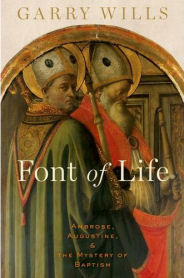
|
Posted February 9, 2012
Book: Font of Life: Ambrose, Augustine, and the Mystery of Baptism Author: Garry Wills Oxford University Press. New York. 2012. pp. 184 An Excerpt from the Jacket:
An Excerpt from the Book: Ambrose’s Town Milan bears the mark of Ambrose, even sixteen centuries after his death. He was Milan’s bishop from 374 to 397 CE, and the ring of churches he created or took over continues to exist in some form. Many things associated with Milan still bear his name --- Ambrosian chant, Ambrosian hymns, the Ambrosian Rite, the Ambrosian School, Ambrosian singers, the Ambrosian Choir, the Ambrosian Library, the Ambrosian Bank, the Ambrosian Picture Gallery, Ambrosian this and Ambrosian that. Down through the centuries streets and shops and little boys were named for Ambrose --- the sixteenth-century Milanese artist Ambrogio Bergognome and Ambrogio Figina both painted their namesake. Local tortellini are called Raviolata d’Ambrogio. The city’s famous opera house, La Scala, begins its season every year on Ambrose’s feast day, December 7, and dedicates its performance to his memory, followed by a banquet paid for by the city, where prizes are awarded in the form of coins incised with a “little Ambrose in gold” (ambrogino d’oro). . . .But Ambrosian memories in the later history of Milan are nothing compared to the hold he had on the place in his lifetime. He clashed with three Roman emperors --- Gratian, Valentinian II, and Theodosius --- who often lived across town from him; and he prevailed in all three conflicts. As the distinguished historian of late antiquity J. H. W. G. Liebeschuetz writes: “In the whole of Roman history, few if any individuals confronted emperors in the way Ambrose did repeatedly . . .whenever we think of the causes he took up, nobody can question that he always displayed exemplary courage both moral and physical.” Even the acerbically secular Edward Gibbons saluted Ambrose, as it were, across a theological barricaded: The palm of Episcopal vigor and ability was justly claimed by the intrepid Ambrose. . . . He condescended, for the good of the church, to direct the conscience of the emperors and to control the administration of the empire . . .He exercised, with equal firmness and dexterity, the power of his spiritual and political characters. Table of Contents: Milan Ambrose’s Town Ambrosian discipline Ambrose fights for his churches Augustine on the way to Milan Augustine in Milan The Baptism Augustine approaches the font Augustine at the font After the font Hippo Baptism in Africa The ritual Augustine needs Ambrose |
|
